2024 PARIS SUMMER OLYMPIC GAMES
- Pool Swimming: July 27 – August 4, 2024
- Open Water Swimming: August 8 – 9, 2024
- La Défense Arena — Paris, France
- LCM (50 meters)
- Meet Central
- Full Schedule
- SwimSwam Preview Index
- Entry Lists
WOMEN’S 4×100 FREE RELAY — BY THE NUMBERS:
- World Record: 3:27.96 – Australia: M. O’Callaghan, S. Jack, M. Harris, E. McKeon (2023)
- World Junior Record: 3:36.19 – Canada: T. Ruck, P. Oleksiak, R. Smith, K. Sanchez (2017)
- Olympic Record: 3:29.69 – Australia: B. Campbell, C. Campbell, M. Harris, E. McKeon (2021)
- 2021 Olympic Champion: Australia – B. Campbell, C. Campbell, M. Harris, E. McKeon – 3:29.69
(No puns today, folks. It’s time to get serious [insert winky face emoji here])
Undefeated at the Olympic level in this event dating back to 2012, the Australian Women enter Paris as the heavy favorite in the Women’s 4×100 Free Relay as they are not only the defending Olympic Champions but also the World Record holders. As a nation, they have held the World Record in the event since 2014, when the team of Bronte Campbell, Melanie Schlanger, Emma McKeon, and Cate Campbell swam to a time of 3:30.98, smashing the supersuited record of 3:31.72 set by the Dutch back in 2009.
Since then, they have lowered it a further four times, twice at the Olympics and most recently last summer at the 2023 World Championships in Fukuoka, Japan. The team of Mollie O’Callaghan, Shayna Jack, Meg Harris, and McKeon demolished the record, setting an unbelievable mark of 3:27.96. Not only did they completely skirt 3:28, lowering the record by an astounding 1.73 seconds, but their margin of victory over the team from the United States was a massive 3.97 seconds.
| SPLIT | AUSTRALIA – 2023 WORLD CHAMPS | AUSTRALIA – TOKYO 2020 (2021) OLYMPICS |
| 1st | Mollie O’Callaghan (52.08) | Bronte Campbell (53.01) |
| 2nd | Shayna Jack (51.69) | Meg Harris (53.09) |
| 3rd | Meg Harris (52.29) | Emma McKeon (51.35) |
| 4th | Emma McKeon (51.90) | Cate Campbell (52.24) |
| FINAL TIME | 3:27.96 | 3:29.69 |
As the only nation to ever have broken 3:30, let alone 3:31, the Aussies seem far and away the winners, but with four swimmers, that is four times the number of chances of DQs or illness to pop up and the Americans, who enter Paris with a reloaded squad from Tokyo, will be looking to pounce on any missteps. The same too can be said for the Chinese, who, in Fukuoka, set an Asian record and have since shown more speed and firepower.
“Winning is not an event, but a habit. You are what you repeatedly do.” – Aristotle
It’s a true enough statement, and the Australian women have lived up to it. Not only are they back-to-back-to-back Olympic Champions, winning in 2012 (3:33.15), 2016 (3:30.65), and 2021 (3:39.69), the last two in both Olympic and World Record fashion. It’s not just at the Olympics, however, that the Aussies have reigned supreme from 2013 to 2024; they have not placed worse than second at the World Championships, winning in 2015, 2019, 2022, and 2023.

However, past precedent doesn’t necessarily mean they are going to win, and recent performances need to be taken into account. Unfortunately, their results, as of late, do not seem to offer much hope to other nations. At their recent Olympic Trials, the 2023 World Champion in the 100, O’Callaghan, swept the competition as she posted a time of 52.33, her 4th fastest performance ever and just off her time from earlier in the season of 52.27, both of which ranked her the 3rd fastest performer in the world this season.
Finishing behind her was Jack. The Australian became one of the country’s great success stories in Fukuoka as she walked away from the meet with three gold medals and two silvers. Despite not having a spot in the individual 100, Jack’s lead-off of 52.28 made her the 10th fastest performer of all time, and she also posted the 8th fastest relay split of all time when she anchored the Aussie mixed medley relay in 51.53.
Jack’s time from trials of 52.72 was a little off her best but was enough to get by Meg Harris and secure an individual 100 swim. Harris swam a prelims time at the 2024 Trials of 52.52, a time that made her the 4th fastest in the world this season and the 11th fastest of all time, and yet because of the limit of two swimmers per nation will be unable to compete in the individual event as was slower in finals and finished 3rd in 52.97.
| 2021 Aussie Trials | 2023 Aussie Trials | 2024 Aussie Trials | |
| 1st place finisher | Emma McKeon – 52.35 | Mollie O’Callaghan – 52.48 | Mollie O’Callaghan – 52.33 |
| 2nd place finisher | Cate Campbell – 52.59 | Emma McKeon – 52.52 | Shayna Jack – 52.72 |
| 3rd place finisher | Madison Wilson – 52.76 | Shayna Jack – 52.64 | Meg Harris – 52.97 |
| 4th place finisher | Meg Harris – 52.92 | Meg Harris – 53.09 | Bronte Campbell – 53.10 |
| Cumulative Time | 3:30.62 | 3:30.73 | 3:31.12 |
| Result at Olympics/Worlds | 1st- 3:29.69 WR | 1st – 3:27.96 WR | ??? |
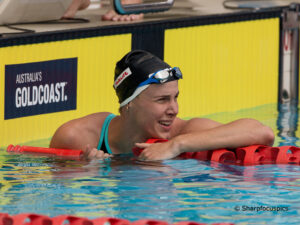 Rounding out the expected relay for the Aussies is a Campbell, but perhaps not the one people were expecting. Bronte Campbell nabbed 4th in the race, qualifying for her 4th Olympics. Her elder sister Cate, a four-time Olympic Gold medalist and the owner of the four fastest 100 free relay splits, including the only sub 51:00, failed to make the team as she finished 9th in prelims and subsequently retired.
Rounding out the expected relay for the Aussies is a Campbell, but perhaps not the one people were expecting. Bronte Campbell nabbed 4th in the race, qualifying for her 4th Olympics. Her elder sister Cate, a four-time Olympic Gold medalist and the owner of the four fastest 100 free relay splits, including the only sub 51:00, failed to make the team as she finished 9th in prelims and subsequently retired.
That said, C2, as Bronte is often called, is an outstanding sprinter in her own right; she holds three Olympic relay medals, 11 long course Worlds medals, and is the 9th fastest performer of all time in the event, swimming 52.27 back in 2018. At trials, Campbell was 53.10 in finals but 52.95 in prelims, a result that makes her the 10th fastest in the world this season (and quicker than her lead-off of 53.01 in Tokyo).
If you’ve been keeping track, then yes, the Australian’s top four swimmers from trials are not only the 3rd, 4th, 7th, and 10th fastest swimmers in the world this season but also the 7th, 9th, 10th, and 11th fastest performers of all time.
To add insult to injury, the 5th and 6th place finishers at trials for the Australians rank as the 15th and 11th fastest this season, with the latter being McKeon, who was the 2021 Olympic Champion in the 100 free and is the only other swimmer besides the World Record holder to have ever been under 52.00.
McKeon actually throws a wrinkle into Australia’s relay options. She will likely qualify for the semifinals of the 100 fly, which are due to take place the same day as the relay, so her participation in the relay is questionable, especially if she hasn’t fully healed from her injury. 7th place finisher Brianna Throssell (53.61) is also on the team, and while slower than McKeon, she did swim a leg in the prelims at the 2023 Worlds. However, if McKeon does swim in the morning and is closer to her best time, does the coaching staff consider using her at night and leaving off either Harris or Campbell?
Whatever the outcome, a conundrum such as this is certainly not going to hold the team back. While, as the chart above shows, their cumulative time is slower than both in 2021 and 2023, there is little doubt that the Australians will be back under 3:30. While it’s not certain that they will break the World record again, the Olympic Record of 3:29.69 is certainly under threat for the third straight edition.
“Winning is more than beating others; it’s about surpassing your own limits and constantly pushing yourself.” – Michael Jordan
It seems like a bit of a cop-out to go with a subheading that allows one to win without actually being atop the podium, but with the Australians’ dominance and the Americans’ lack of success in usurping them, it seemed fitting. Perhaps a better quote would have been from The West Wing, when CJ Cregg said, “We’re moving the goalposts and claiming the match.” (that said, and somewhat counter to the Article title and quote above, it would be incredible to see the US win this. And if they did, would it be a greater upset than the US vs France in 2008?)
And I think a perfect location for that goalpost would be the American record. The US last won a major international gold medal in this event at the 2017 Worlds, when they beat the Aussies to the wall, stopping the clock in 3:31.72, a then-new American record. Two years later, despite a reversal of spots on the podium, the US again lowered the American record to 3:31.02. Since then, in the intervening five years, the US hasn’t been close, finishing in 3:32.81 at the Olympics (3rd), 3:32.58 at the 2022 Worlds (3rd), and 3:31.93 last summer (2nd).
However, the results of the recent US Trials seem to support that positive trend of time drops and show that the record is under serious threat.
| 2018 Trials (for 2019 Worlds) | 2021 Trials | 2022 Trials | 2023 Trials | 2024 Trials | |
| 1st place finisher | Simone Manuel – 52.54 | Abbey Weitzeil – 53.53 | Torri Huske – 53.35 | Kate Douglass – 52.57 | Kate Douglass – 52.56 |
| 2nd place finisher | Mallory Comerford – 53.09 | Erika Brown – 53.59 | Claire Curzan – 53.58 | Abbey Weitzeil – 53.11 | Torri Huske – 52.93 |
| 3rd place finisher | Margo Geer – 53.44 | Olivia Smoliga – 53.63 | Erika Brown – 53.59 | Gretchen Walsh – 53.14 | Gretchen Walsh – 53.13 |
| 4th place finisher | Abbey Weitzeil – 53.56 | Natalie Hinds – 53.84 | Natalie Hinds – 53.65 | Olivia Smoliga – 53.28 | Simone Manuel – 53.25 |
| Cumulative Time | 3:32.63 | 3:34.62 | 3:34.17 | 3:32.10 | 3:31.87 |
| Result at Olympics/Worlds | 2nd – 3:31.02 AR | 3rd – 3:32.81 | 3rd – 3:32.58 | 2nd – 3:31.93 | ??? |
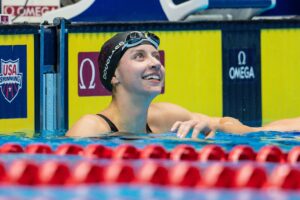
Kate Douglass (photo: Jack Spitser)
There is a lot of data and numbers to process, but the key draws are these: One, it’s the first time that the US has ever had two swimmers under 53 in the finals of the event, and second, their cumulative time together is faster than it has been before. If these four swimmers can replicate those performances (and subtracting a conservative .4 for relay exchanges), the US women could be knocking on the 3:30 barrier. To note, the American Record of 3:31.02 was set by the team of Comerford (52.98), Weitzeil (52.66), Kelsi Dahlia (53.46), and Manuel (51.92) at the 2019 Worlds.
That said, last year’s cumulative time was also faster than the time in 2019, but the end result was slower. Much of that can be explained by Gretchen Walsh, who led off in 54.06, nearly a second slower than her time from trials. However, it was on the back of a double with the semifinals of the 100 fly, a fate that likely will befall both her and Torri Huske again.
Similar to the Australians, the US has some options to play with. Kate Douglass, who dropped the individual event, could swim in the morning in place of Walsh and join Simone Manuel, Abbey Weitzeil, and Erika Connolly (nee Brown), the latter three of whom have years of relay experience, with Manuel being the American record holder and 2016 co-Olympic champion in the event. While the US can’t compete with Australia’s firepower, this is the closest they may be in the last 5 years as the top four all rank within the world’s top 15 this year, led by Douglass at 5th with her 52.56. If it sorts out that Walsh and Huske can manage the quick turnaround from the 100-fly semis to the the relay, the US should be in a good position for a new record and the silver medal.
Progress is the activity of today and the assurance of tomorrow — Ralph Waldo Emerson
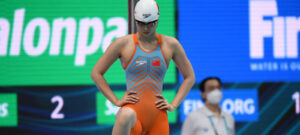
Yang Junxuan, courtesy of Fabio Cetti
Time moves differently in relays as compared to individual events. I don’t mean the minutes and seconds but rather the journey it takes to develop a team. Swimmers can pop up and go from newcomers to stars in just a year, but to have a relay improve takes a sustained effort by more than one swimmer, as you need four (or more) swimmers to all be hitting their strides at the same moment as well as the depth necessary to provide such an opportunity.
Seeming to be hitting their stride at the exact right time are the Chinese. In 2019, their team finished 6th in 3:35.83. Two years later, at the Olympics, they finished down one spot but in a new Asian record time of 3:34.76. In 2022, while slower, they improved to 4th in the world, and last summer in Fukuoka, they were rewarded with a new Asian record of 3:32.40, a bronze medal, and just .47 away from the silver.
Looking into this year, the Chinese may be in line to continue that trend and look to pounce on any missteps by the Americans. Yang Junxuan made the final in the 100 last summer but finished 8th in 54.09 and had a semifinals time of 53.67. However, this past May, she rocked the world with a new Chinese record of 52.68 to not only become the 8th fastest in the world but also the 16th fastest performer of all time.
A little further back, her fellow compatriots Wu Qingfeng (53.25), Zhang Yufei (53.27), and Cheng Yujie (53.27) all put up top 20 times in the world this season as well from the same meet. With Yang’s improvements, they could easily be under 3:32, as their trial times, when added, come to 3:32.47. However, like McKeon and the American pair, Zhang will have to contend with the 100-fly semifinals overlapping with the relay.
In a seemingly similar position as the Chinese are the team from Great Britain. They did not field a relay in 2019 but finished 5th at the Olympics in 2021. Their time of 3:33.96 set a new national record that would stand just for two years as the same quartet finished 4th in Fukuoka, chopping .06 off the record. The relay comprised of Anna Hopkin (53.67), Lucy Hope (53.53), Abbie Wood (54.19), and Freya Anderson (52.51).
However, whereas the Chinese swimmer had a strong performance at trials, the Brits did not. Hopkin won in an impressive 53.33, but the remainder of the team struggled. Anderson, who was battling with glandular fever was 54.59. Hope and Wood did swim in the final but were just 55.35 and 55.26, respectively, finishing 7th and 6th. Eva Okaro, just 18, had a strong showing to place 2nd in 54.46, but with Anderson’s poor performance and Freya Colbert‘s 55.10 for 4th, it doesn’t seem likely that they can recapture that magic, but if Anderson recovers fully, then they still will likely final.
“Our greatest glory is not in never falling, but in rising every time we fall.” – Confucius

courtesy of Fabio Cetti
After winning the bronze at the 2016 Olympics, Canada would become a medal favorite in the event, claiming bronze again in 2019 establishing a new national record of 3:31.78. Two years later, at the Olympics in 2021, they claimed silver in 3:32.78, out-touching the Americans by .03. 2022 saw another silver medal, as the team again beat out the Americans once again, finishing in 3:32.15 this time with a margin of .43.
One year later, however, the Canadian fell off the podium and plummeted to 7th place in the event. Penny Oleksiak, the 2016 co-Olympic Champion was absent from the squad dealing with injuries. Taylor Ruck, who had been a stalwart of the team dating back to 2016, was battling with a hand injury, and Kayla Sanchez, who won two medals at the Olympic Games in Tokyo, had begun to switch her sporting nationality to the Philippines and was therefore unable to represent Team Canada.
The team finished in 3:36.62 and was led by Summer McIntosh‘s lead-off leg of 54.99, and while she is a first-rate swimmer, the 100 free doesn’t share too many similarities with the 200 fly and 400 IM, events in which she claimed gold later on in the week.
In May, at Canada’s Olympic Trials, Oleksiak, the national record holder (52.59), earned her spot on the Olympic team by virtue of winning the 100 free, but her time of 53.66 was outside the qualifying time and did not give her an opportunity to swim the event individually. Likely joining Oleksiak on the relay are Mary-Sophie Harvey, who placed 2nd in 53.71, Brooklyn Douthwright (3rd – 54.33), and Ruck (4th – 54.47).
The Canadians do have some options, though, and could improve in the finals, should they advance. Maggie MacNeil, the reigning Olympic Champion in the 100 fly, has three medals to her name in this relay and was the lone bright spot on the relay last summer as she split 53.07. McIntosh, too, could come in as she anchored their medley relay at the end of the meet in 53.48. The issue, which affects many of the teams above, is that the relay conflicts with other events, in this case, MacNeil’s 100 fly and McIntosh’s 400 free, so the coaches must judge their ability to recover against the swims from those that swam in prelims.
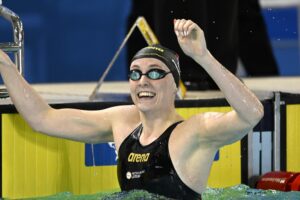
Marrit Steenbergen courtesy World Aquatics
In a similar vein to the Canadians, but in a longer (somewhat) slump, are the Dutch. The Netherlands’ sprinting prowess was at its height in the 2000s. They won a medal of each color at the Olympics capped by a gold at the 2008 Games, and were just .14 off their World Record time of 3:33.62. A year later at the peak of super-suits, the Dutch would re-broke the record, lowering it to 3:31.72 (a mark that stood til 2014).
Even without the suits, the team won at the 2011 Worlds and claimed silver at the London Games. Yet slowly, with retirements, those golds and silvers turned to bronzes, and by 2019, they had fallen out of the medals. They have always been in the finals but have been relying on the prowess of Marrit Steenbergen, who, despite a 51.84 split, finished 6th last summer in a time of 3:35.41, more than three seconds back of the medals.
We haven’t spoken much about the 2024 Worlds in this article, and for good reason. While one cannot take away the accomplishments and medals from the meet, the placing bears little relevance to this article as it was a sparsely attended meet. The Dutch team of Kim Busch, Janna van Kooten, Kira Toussaint, and Steenbergen topped the podium, claiming gold, but in 3:36.61, more than a second behind their time in Fukuoka.
That said, Toussaint’s split of 53.81 was faster than any of the splits from 2023, save Steenbergen’s, so the Dutch could find themselves on the upswing once again, if the backstroker can replicate that performance.
“One person can make a difference…” – JFK
Of the two teams not yet mentioned from the 2021 Olympic final, Sweden appears to have the better shot at making the final. Denmark, which finished 8th in Tokyo, fell to 14th in 2023 and hasn’t yet recovered from Pernille Blume‘s retirement. The Danes were 3:38.48 at Euros, which was good for silver, but they will need to find at least another half-second to have a hope of making the final.
Led by the individual WR holder, Sarah Sjostrom, Sweden finished 6th in the Olympic final (3:34.69). Two years later, in Fukuoka, Sjostrom posted the second fastest lead-off time (52.24) as Sweeden finished 5th in 3:34.17, qualifying for these Olympic Games. Sjostrom has four Olympic medals and 25 long-course World medals to her name, but just two of them come from relays (both medley). While she could add more, it seems unlikely to come from this relay.
Sweden’s record comes from 2017 when the team finished 5th in a time of 3:33.94, and while three swimmers from that relay will be in Paris, that time came on the back of Sjostrom’s 51.71 World record, and Michelle Coleman‘s recent results seem to imply she won’t be able to replicate her 52.68 split.
Like Sweden, Hong Kong’s success and ability to qualify for the event has been on the back of Siobhan Haughey. The third fastest performer in the event ever, Haughey, who swam collegiately for Michigan, split 52.59 for the Hong Kong squad as they finished 12th in the prelims in Fukuoka. Her time was the only swim under 55 as the team set a new national record of 3:39.93. However, despite Haughey’s recent PB of 52.02 being a half-second improvement upon her split, it’s unlikely that she alone can get her team into the final.
“Doing your best means never stop trying” – Benjamin Franklin
With Japan opting not to use their relay berth (Ireland will now have the opportunity to field a relay), the fight for that 8th spot will be tight. At the 2023 Worlds, both Italy and France were less than a second outside of making the final, and Poland took the opportunity to qualify for the meet at the 2024 Worlds, where they set a new National record of 3:38.65.
- Italy: In 2023, the squad didn’t have any lights-out performance, with the fastest split of 54.14 belonging to Costanza Cocconcelli, but recorded a mark of 3:37.93 as they finished 9th. A little worrying, the same foursome finished 5th in Doha but in a slower time of 3:38.65. However, Sofia Morini swam 53.92 at Sette Colli recently, and Chiara Tarantino was 54.05 in March, so the Italian squad could be in line for a good drop.
- France: The French, too, had middling results in Fukuoka, finishing in 10th with a time of 3:38.52, with no split under 54.3. However, perhaps inspired by the chance to compete in front of a home crowd, Marie Wattel popped off an OQT of 53.59 at the French Trials. Beryl Gastaldello, who was 53.60 earlier in the year, also earned an individual berth in Paris, and with a 54.08 from Mary-Ambre Moluh, it’ll come down to Charlotte Bonnet and if she can get close to her national record of 52.74.
- Poland: Led by a Polish record from Katarzyna Wasick (54.12), the quartet will be one of only two teams to use their results from Doha to qualify for the Olympics, the other being Slovenia. While Wasick is a medal threat in the 50, her 100 speed is likely not enough to get Poland into the final without help.
The Verdict
(before I go further, just know that every swimmer at this level is a winner. Everyone out there right now who fell just short of making the Olympics is a winner. Everyone who tried their best or even just tried is a winner. It’s the action, it’s the effort, it’s the attempt that sets you apart. Winning is a mindset; chase it. – corny? Yes, but I also genuinely feel it).
This section should be mercifully short if you are tired of reading. Australia would need a disqualification, injury mid-race or some act of a supernatural being to lose this race.
And yet, it’s not a 100% lock. The US times from trials, when summed, are within a second of the Aussies, and while all the Australians were off their bests in the final, we can’t assume that Jack will be able to split 51 mid again, nor do we know if Bronte can swim in the 52 low range. Nor, however, can we assume that the Americans will be able to replicate their times. That said, if I were a betting man, I’d say the Aussies are going to win but fall short of breaking the World Record.
After them, I think it’s silver for the Americans and bronze for China, a repeat of the 2023 podium. Unlike individual events, relays are much more likely to follow a similar pattern from previous years based on having four swimmers and the lessened impact of what one-star swimmers can do. As such, I think that Great Britain, Sweden, the Netherlands, and Canada will make the final, albeit in a different order.
Mary-Sophie Harvey‘s improvement in the 100 free and the return of Oleksiak should give a boost to Canada. Great Britain’s illness woes are a cause for concern and do hurt their chances but not enough to knock them out of the final. Sweden and The Netherlands are an interesting case, but Sweden seems to have a stronger supporting cast around Sjostrom. For the last spot, we are giving the edge to France. While Italy was over half a second faster last summer, France’s likely swimmers from their Trials have a summed time of 3:35.97, and that’s without any relay exchanges.
SWIMSWAM’S PICKS
| RANK | Team | National Record | Entry Time |
| 1 | Australia | 3:27.96 | 3:27.96 |
| 2 | USA | 3:31.02 | 3:31.93 |
| 3 | China | 3:32.40 | 3:32.40 |
| 4 | Canada | 3:31.78 | 3:36.39 |
| 5 | Sweden | 3:33.94 | 3:34.17 |
| 6 | Great Britain | 3:33.90 | 3:33.90 |
| 7 | Netherlands | 3:31.72 | 3:35.41 |
| 8 | France | 3:34.65 | 3:38.52 |
Dark Horse: Hungary – Hungary placed 13th at the 2023 Worlds in a time of 3:40.02, and while that may seem to be quite a stretch, results from the recent European Championships may prove otherwise. The team in Belgrade smashed their way to the win, setting a new national record of 3:36.77, a time that would have placed 7th at the 2023 Worlds. The biggest difference between the two relays was the addition of Panna Ugrai, who split 53.88, and Nikolett Padar, dropping from 55.13 to 53.67 on the anchor.
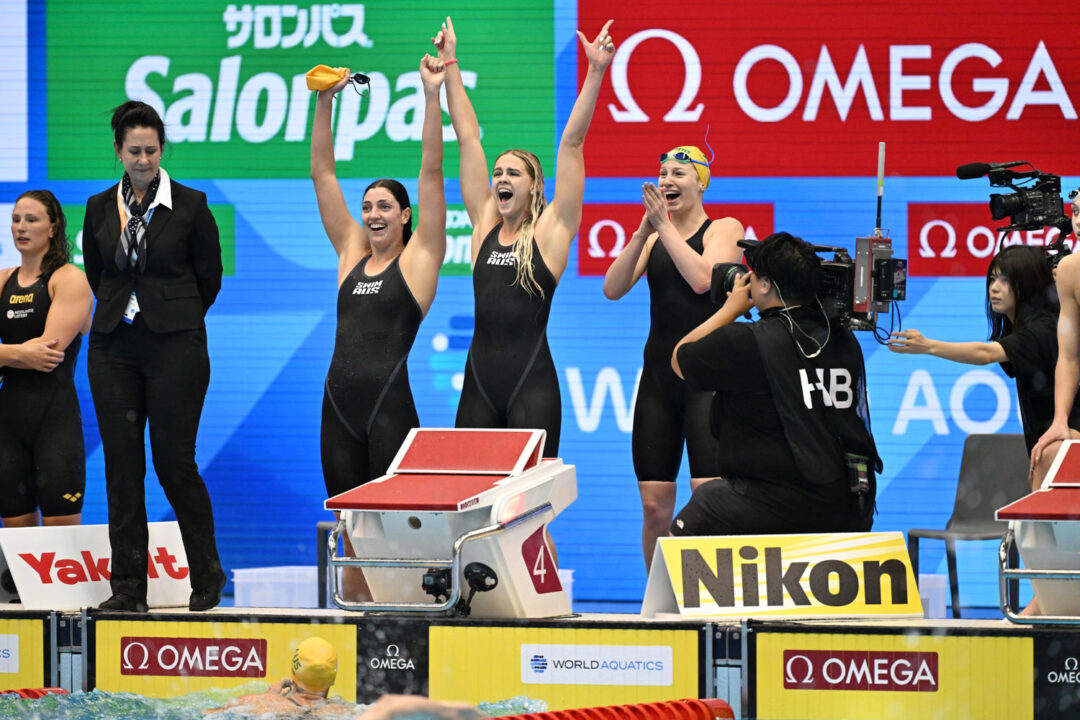
Why is everyone conjecturing as if this race will be fair? Two of the projected top three finishers will include undisputed dopers in their lineups.
I’m not sure that “undisputed” is the word that fits either case.
While it’s true team Australia is the overwhelming favorite, they will still need to swim at near perfection if they are to beat the new and improved US team.
Since Fukuoka, Gretchen Walsh has only become faster, the fastest woman in SCY, Simone Manuel is back, and Douglas will be well rested with a lighter schedule. Torri Huske has also been on fire this entire year. The USA women have never been closer to the Aussies.
It will take a WR or something very close to it, to win gold. Anything less than that from the Aussie women opens the door for team USA.
1. AUSTRALIA
2. USA
3. CHINA
If Manuel continue to drop time and gets close to her PB, then USA will have a serious chance
True! She swam three 200’s at trials before her 100’s. For a sprinter that takes a huge toll. I think she’s capable of swimming faster.
Edited
Last year in Fukuoka, Mollie swam 52.0 in 4×100 free 🥇WR, and then 3 rounds of super elite 200 free culminating in 1:52 🥇WR, and then 3 rounds of 100 free culminating in 52.2 🥇.
Funny how you Aussies always skip Doha to talk about Fukuoka lol. Fukuoka must be the highlight of every Aussie swim fan despite placing second on the medal table lol.
Who you talking to?
I’m not even Aussie.
I don’t have Australian passport, I don’t even live in Australia, English is my fourth language, yes I speak four languages fluently. A concept and reality I’m sure you can’t grasp.
Just because I have affinity to Australia and some of my favorite swimmers are Australians does not make me Australian. My country does not even have world class swimmers.
Swimswam’s most famous reader is BoboGigi. He knows SO MUCH about American swimmers, he loves America NAG swimming and always strongly supported American swimmers during the Olympics and World Championships. His favorite swimmers are American swimmers. He even threw shades at Australian swimmers during London Olympic and in the lead up to… Read more »
You’re not making any sense, so I’ll disengage.
most people will be pretty happy if you disengage. Not much of what you say makes sense.
Everyone skips Doha because it wasn’t a competitive worlds. Or do you still think Curzan is going to do the backstroke double in Paris?
nobody prepared fully for Doha. Not the athletes pushing for medals in Paris.
If Bronte Campbell continue to drop time and gets close to her PB, then it’s over.
Only the Americans are allowed to be faster in the Paris!
D’oh! How did I forget that rule!
Actually, Gretchen Walsh 100 free barely gone faster from last year.
2023 US trials 53.14
2024 US trials 53.13
“Douglas will be well rested with a lighter schedule.”
You know that w4x100 free is on the first day, the same as last year’s right?
And just like Gretchen, Kate’s 100 free barely gone faster than last year.
2023 US trials 52.57
2025 US trials 52.56
Douglass had the 200 Im in the same session last year.
The heats and semis of the W 100 FL/W 200 IM and the heats and final of the W 4 x 100 FR-R are scheduled on Day 1 of the World Aquatics Championships.
Based on finals times at trials
MOC 52.33
KATE DOUGLAS 52.56
JACK 52.77
HUSKE 52.93
HARRIS 52.97
CAMPBELL 53.10
WALSH 53.13
SIMONE 53.25 ****
Two US swimmers have faster times than their Aussie counterparts. Simone will almost certainly outsplit Campbell.
Australia still wins but it will be much closer than most people think.
Simone will certainly outsplit Campbell?? Bookmarked.
come on you’re talking to swimdad here. With good taper she can even out-split MOC and if she leads, will break the WR. Actually, at least 3 women on the US team will be under the WR.
It really is game over, Team Aus should just pack their bags and go home.
Thank you for providing another evidence.
Screenshot, saved and bookmarked!
Define “Aussie counterparts”? If you take AUS 1 vs USA 1, AUS vs USA 2 and so on, Australia wins all four matchups and none of them are particularly close.
almost certainly? based on what?
How about a dose of reality?
52.96 + 53.13 – 0.51 + 52.56 – 0.37 + 52.14 = 209.91
Torri Huske’s best lead-off split in the final of the W 4 x 100 FR-R at a major international competition is 52.96. If Simone Manuel could match her relay split (52.14) from the final of the W 4 x 100 FR-R at the 2017 World Aquatics Championships, USA Swimming barely gets under the 3:30 mark (3:29.91) in the W 4 x 100 FR-R. USA Swimming needs to be a helluva lot closer to (if not under) 3:29 than 3:30 to have any chance of a gold medal in the W 4 x 100 FR-R.
A lead-off split of 52.96 in the… Read more »
“new and improved”: Their trials times are 0.23 faster than last year where they lost by 4 seconds
Canada can really get three 4th places in the relay races, they probably have their best team of the last decades and could still get a frustrating olympics, with masse too having chances of getting two fourth places in the backstroke races, I hope she manages to win a bronze medal
Much of that can be explained by Gretchen Walsh, who led off in 54.06, nearly a second slower than her time from trials. However, it was on the back of a double with the semifinals of the 100 fly, a fate that likely will befall both her and Torri Huske again….
Huske is a queen of doubles..Gretchen has to earn his final spot..cuz most of swimmers get faster in relays..witzel always does..
This is true. But even if Walsh matched her PB that only drops like 0.9
I think many did not get my comment..the first paragraph is from the article..I m saying that Walsh will not go 52s in relays..with that 100 fly in same session..Walsh has to earn the spot..May be witzel will sneak into final..regarding huske; she has tons of experience dealt with even triples in same session..I trust her
Typically, the two fastest swimmers in the W 100 FR at the Olympic Team Trials receive byes into the final of the W 4 x 100 FR-R.
Not always right..last year at fukuoka witzel had to do prelims duties for Walsh. Witzel was an individual enrant..did not receive your so called free bye..
Prediction:
Australia
United States
China
Canada
France
Sweden
Netherlands
Great Britain
When I was doing the math here I was extremely surprised to see how good the French team is, at least on paper. Their PB add-up is 3:33.34, which is faster than both Canada and Sweden. Using 2024 times, they still rank 5th, this time behind Canada. Their slowest swimmer is 54.08, and while Charlotte Bonnet has regressed from her 52.74 PB, she can probably still put down something respectable with the home crowd.
Anyone know why Bonnet moved away from freestyle?
Yes but Sweden’s PB relay split equals 3:32.18… Sjostrom 51.71, Coleman 52.68, L.Hansson 53.51, Junevik 54.28.
I gave 5th to France because I think the 4×100 is an event uniquely positioned for the home turf advantage to have its maximum effect; if this wasn’t the Paris Olympics I would’ve given Sweden 5th place.
The math (using the four swimmers most likely to swim in each team):
Using PBs, Australia is 1.48s ahead of the US on a flat start, US is 1.46s ahead of China.
Using best times from the Olympic Qualifying period, Australia is 1.85s ahead of the US, US is 0.78s ahead of China.
Using best times from 2024, Australia is 1.29s ahead of the US, US is 0.79s ahead of China.
No other team has the depth of these three at the moment. Canada is between 1.75-2.81s behind China based on which datapoint you look at.
So the advantage for Australia is not as big this year without Emma McKeon in the relay lineup (although it’s certainly possible she’s… Read more »
Zhang Yufei will also have 100 fly double.
There’s still a small chance Australia will swim Emma in relay final so it would be double double for her (100 fly prelims and semis + 4×100 prelims and final), but I think it will most likely be Mollie – Meg Harris – Campbell – Jack in the final. B Campbell could be replaced by Wunsch if Wunsch swim much faster prelims, but if her swim is barely faster, they’ll pick proven relay racer Bronte any day.
Last year G Walsh didn’t swim 4×100 free prelims. This year, I think they’ll make G Walsh swim 4×100 free prelims. Final would be Huske – the fastest 2 out of prelims (G Walsh –… Read more »
Huske is a master of doubles ..no doubt on her
Walsh and Manual faster than trials… and a couple of Aussies will be a bit off…. resulting in….
An American upset in this one!
Now… only the end of times will prevent Australia women from winning the 800 FR
Sjostrom has confirmed to Swedish Media today that she will swim the 100 free in Paris (no longer decide after the relay) as there are enough rest days before the 50 starts!
The race for the podium and the gold just got a lot spicier
Any of these 5 can win gold:
Mollie, Haughey, Steenbergen, Sjostrom, Jack.
I’m leaning towards Mollie for gold, medals will be fiercely contested.